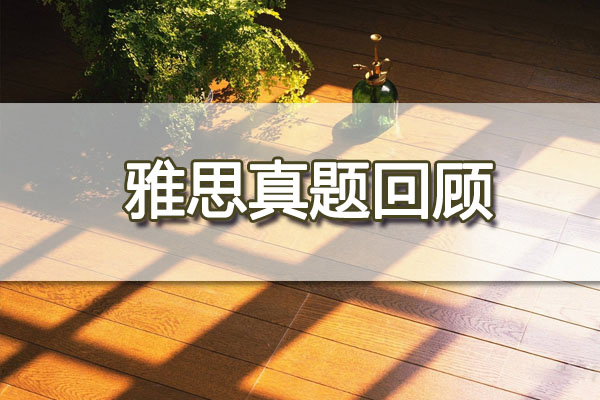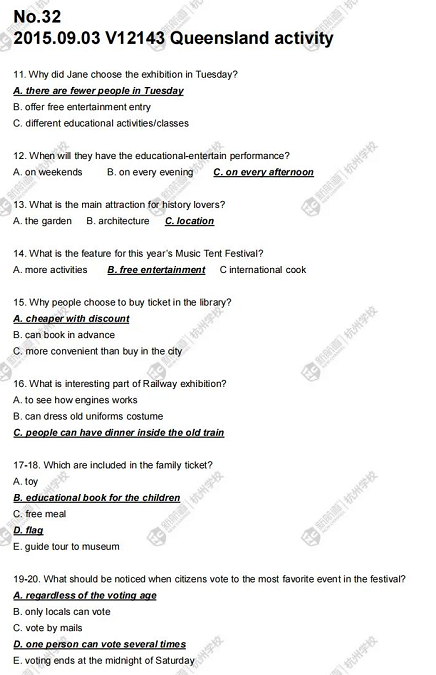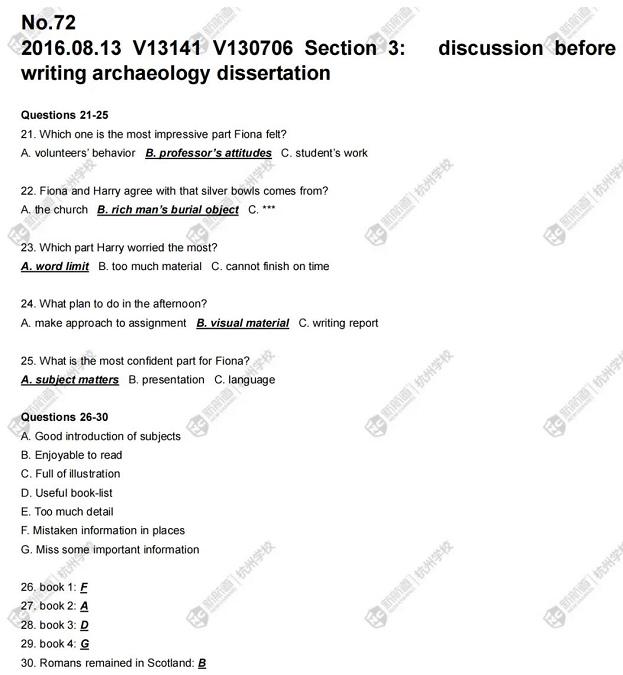2022年9月3日雅思考试真题答案已经发布,9月3日雅思考了哪些内容?9月3日雅思真题答案是什么?下面请随新航道雅思培训小编一起来看看。

一、9月3日雅思听力听力考情
9月3日雅思听力考试为两篇新题两篇旧题,各部分的场景和题型还是比较常规的。根据考试同学的回忆来看,听力语速偏快,有同学反馈体验很好,下次可以再来。考生们可以从分析中整体了解下每部分考察的主题和题型。
新旧情况:2新+2旧
雅思听力题目1:新题
场景:女士为儿子咨询Melbourne Sports Camp
题型:10填空
1. swimming
2. High
3. fitness
4. competition
5. hat
6. ball
7. diet
8. 4.30 (pm)
9. Costa
10. 0419..22..
P1点评:该场P1考察的是常规的咨询场景和笔记填空题,具体内容是报名运动夏令营sport camp,因此涉及到了一些运动相关的专业词汇,如soccer,tennis,swimming等,建议各位考生平时注重同场景词汇的积累。除此之外,第2题的地名考点High Street,第9题教练的名字costa,00题的数字听写,都在提示我们平时需要扎实练习这些基础考点。
雅思听力题目2:旧题
场景:女士介绍Queensland Music Festival
题型:6单选+4多选
参考《新航道雅思听力速递机经S2&S3》No.32 P32
11. B fewer people
12. C every day afternoon
13. A cheaper
14. C The location
15. B free entertainment activities
16. C eat in the train
17. B children’s book
18. E a flag
19. A people of different ages can vote
20. D you can vote for several times

P2点评:该场P2和我们《新航道雅思听力速递机经S2&S3》的第32篇内容基本相似,各位同学可以进行答案词参考。建议各位同学平时在练习真题相关选择类题型的同时,也可以根据机经内容进行良好的场景预判。
雅思听力题目3:旧题
场景:Archaeology 考古学作业讨论
题型:5选择+5配对
参考《新航道雅思听力速递机经S2&S3》No.72 P218
21. B The attitude of archaeologist
22. B buried with a person
23. B visual materials
24. A the word limit
25. A The research subject
26. D wrong location
27. C good instruction to the subject
28. G useful book list
29. A enjoyable to read
30. E omit some important information

P3点评:该场考试P3部分还是一如既往熟悉的搭配:学术场景+选择配对题,是整套题中难度系数相对较大的一个部分,让很多考生感到头疼。针对P3高频场景和题型,考生一方面需要积累学术场景相关词汇;另一方面可参考剑桥真题P3部分进行题型的横向训练,专项解决考点问题(如审题/排干扰/替换等)。
雅思听力题目4:新题
场景:Port Cycle 商业经营
题型:10填空
31. food
32. doors
33. circle
34. transportation
35. tax
36. logo
37. 待回忆
38. 待回忆
39. 待回忆
40. wrappers
P4点评:该部分题干回忆部分暂时缺失,答案词仅供参考。该场景主题是关于环保回收再制造的公司,涉及到部分较难词汇wrappers,因此考生需要重点关注,并结合剑桥真题进行练习。
二、9月3日雅思口语考情分析
本篇主要收录2022年9月的雅思纸笔口语和机考口语题目。请大家结合题库,本份0进行构思、准备、演练。
Part12 红色题为必备考题,紫色题为第二重点优先准备
*重点优先按顺序准备题目,一边刷题库,一边整理语料,根据0来高效准备,尽量考前确保所有0都有按顺序刷过一遍,做到心中有素* (文档结尾附备考建议)
三大应该会考到题:Work or study/ Hometown/ Accommodation
Part1 必备考题
Singing /Geography /Social media /Puzzles /Technology /Cooking/Transportation /Names/Birthday /Writing /Weather /Snacks
Evening times/Computers/Daily routine/Taking photos / Watches/Old buildings /Talents/Collecting things/Boring things/Meeting places/ Sports /books and reading habits
advertisement /Mirror/Dreams /Arts /Websites/Cinemas/Street markets /E-mails/Time Management / Lost and found /Concentration/TV program / Sitting down/dreams
Part2 必备考题
Describe a time when you needed to search for information
Describe a time when you saw a lot of plastic waste (e.g. in a park, on the beach etc.)
Describe the home of someone you know well and that you often visit
Describe a movie you watched recently and would like to watch again
Describe an outdoor activity you did in a new place recently
Describe a program you like to watch
Describe a friend from your childhood
Describe a photo you took that you are proud of
Describe a disagreement you had with someone
Describe an important thing you learned (not at school or college)
Describe a person who is fashionable
Describe a song/a piece of music you like
Describe a person you know who is from a different culture
Describe a time when you received money on your birthday
Describe an experience of online shopping
Describe a popular place for sports (e.g. a stadium)
Describe a story you have heard about
第二重点准备
Describe an occasion when someone gave you positive advice or suggestions about you work
Describe a long walk you ever had
Describe something you received for free
Describe a family member who you want to work with in the future
Describe an interesting neighbor
Describe an important river/lake in your country
Describe a quiet place you like to go
Describe a special day out that cost you little money/didn’t cost you much
Describe something you do to keep fit and healthy
Describe something that surprised you
Describe a contest/competition you would like to participate in
Describe a traditional product in your country
Describe an invention that has changed the world in a positve way
Describe a gift you would like to buy for your friend
Describe a person who contributes to the society
Describe an important event you celebrated
Describe an ambition that you haven’t achieved yet
Describe a person who you follow on social media
Describe a difficult decision that you once made
Describe a way that helps you save a lot of time
Describe an occasion that you lost something
Describe something you do that can help you concentrate on work/study
Describe a positive change that you made
Describe a famous person in your country
Describe a time when you helped a child
Describe a thing you did to learn another language
Describe an item of clothing that someone gave you
Describe a story someone told you and you remember
Describe a course that impressed you a lot
Describe a skill that you learned from older people
Describe someone you really like to spend time with
Describe a time you visited a new place
Describe a house or an apartment which you would like to live in
Describe an interesting song
Describe a city that you think is interesting
Describe a rule that you don’t like
Describe a special cake you received from others
Describe a time when you organised a happy event successfully
Describe a toy you liked in your childhood
Describe something that you can’t live without
Describe a village that you visited
雅思口语备考技巧分享:
换题季的时候,对考生的备考建议是认真准备已知新题,尽可能的结合之前准备过的语料素材,高效循环使用自己比较熟悉的内容和表达,但是要注意要做到“有效地”充分利用。
在把新题目和旧素材进行组合的过程中,要注意合理改造旧素材来匹配新题目,使得故事表达听起来是专门为这个题目“量身打造”的,切记生搬硬套,这样很容易让故事偏离题目要求、或者听起来非常僵硬和不合理。
9-12季度目前出现的新题目都难度适中,对于上个季度就开始备考的考生来说,题目的范围基本上都是意料之中的,稍加整理,应该就可以应对。
Part1目前出现新题,基本上都是我们的“老朋友”,即:之前往季出现过的题目或类似改编题目,都是在日常生活范畴之内的,难度不大。
Part2的新题中,目前来看,有三个题目需要特别注意:1.电影;2.节目;3.歌曲/音乐。这三个题目需要考生提前构思、准备,才能说得言之有物,令人信服,不然考试的时候,如果临时抽到这类很具体细节的题目,很容易出现故事空洞和没想法的情况,需要考生特别留心。建议考生从自己的爱好和经历入手,使得故事听起来比较真实可信,并且比较具有个人色彩为宜。
Describe a movie you watched recently and would like to watch again
Describe a program you like to watch
Describe a song/a piece of music you like
三、9月3日雅思写作考情
小作文:动态表格,主题是关于2011-2015年澳大利亚四种乳制品的年度人均消耗量的变化。
一般来说,表格题的数据往往比较的多,但大家也不需要惊慌,相较于静态的表格,动态的表格相对来说会简单一些些。我们仍旧可以按照动态图的常规思路,去观察变量变化的趋势,在宏观概括中总结出变量发生的变化是相似还是不同,然后按照变化的不同趋势进行分段,一般可以按照增长和下降分成两段。然后挑选数据进行比较来支撑中心句。在比较数据的时候需要注意,做出相关的比较,比如一些同学会非常在乎最 大值和最小值,但如果是在动态图中往往趋势才是关注的重点。
大作文:Some college freshmen find that the courses they choose are not suitable for them. What are the causes of this? What can be done to solve the problem?
一些大一新生发现他们选择的课程不是很适合他们。原因是什么?可以怎么样解决这个问题?
大作文考查是report的文章,问的是原因和解决措施。主体段两段可以分别去回应原因和解决措施。回想我们上大学的时候,确实会发现自己选择的课不是很适合自己,那么是什么原因导致了这个现象呢?这边推荐写的原因可以是学校没有提供一些相关的信息让学生了解到他们所选的课程上的是什么内容,以及这些课程适合什么样的学生上,所学的内容以后可以运用在哪些方面。比如说如果一个课程需要阅读外文比较多,那么如果能够提前和学生说明情况,一些外语水平比较差的学生可能就不会轻易选择这门课从而避免了自己未来为了完成作业,痛苦阅读外文文献的尴尬情况。针对解决措施。1. 学校可以开设相关的课程,介绍不同课程的上课内容以及适合哪些学生上课,让学生根据自己的需求去进行选择。2.可以在学校的论坛中设置相关的版块,提供新生跟学长学姐的交流机会。通过询问上过相关课程的学长和学姐的建议来决定自己是否要选择相对应的课程。
四、9月3日雅思阅读考情
9月3日雅思阅读方面考生们要注意的是,每天1/5/9月的换题仅针对于口语,笔试部分还是正常备考就可以了。9月3日的雅思阅读的三篇虽都为旧题,但是总共只有3道填空还是让很多考生措手不及。
Passage 1 A Brief History of Tea 茶叶的历史
首 次出现:2008.11.15
类别:历史
难度:★★
题型配比:List of headings8+特殊词匹配5
参考答案:
List of heading:
Para A viii A chance discovery
Para B iv A connection between tea and religion
Para C x Tea-making as a ritual
Para D vi News of tea reaches another continent
Para E v A luxury item
Para F vii Is tea a good or bad thing?
Para G iii in-and sometimes out of- fashion
Para H xi Difficulties in imparting tea
特殊词匹配:
9. Claims that tea might be harmful failed to affect its popularity. D Holland
10.Tea lost favour to other drinks. E France
11. Special buildings were constructed in which to drink tea. B Japan
12. Animals were involved in importing tea. G Russia
13. A ruler’s specialist knowledge led to an interest in tea.A China
分析:今天的passage1收录在剑10海外版中,是官方正式版剑10出现之前的一个“民间版本”,其实就是亚太考区的机经真题。文章的内容难度不大,且茶叶的历史相关话题已经在考试中出现多次。但值得注意的是,今天的这篇passage1题型搭配可不一般:不是传统的填空+判断黄金组合,一样来就是段落小标题配对还是会让不上场这一题型的考生心理犯怵。建议先处理特殊词匹配再来搞定headings,或者也可以利用平行阅读法处理。
READING
PASSAGE 1
You should spend about 20 minutes on Questions 1-13, which are based on Reading Passage 1 below.
Question 1-8
Reading Passage 1 has eight paragraphs, A-H.
Choose the correct heading for each paragraph from the list of headings below.
Write the correct number, i-xi, in boxes 1-8 on your answer sheet.
List of Headings
i Not enough tea to meet demand
ii Religious objections
iii in – and sometimes out of – fashion
iv A connection between tea and religion
v A luxury item
vi News of tea reaches another continent
vii Is tea a good or bad thing?
viii A chance discovery
ix The benefits for health
x Tea-making as a ritual
xi Difficulties in importing tea
1 Paragraph A
2 Paragraph B
3 Paragraph C
4 Paragraph D
5 Paragraph E
6 Paragraph F
7 Paragraph G
8 Paragraph H
A Brief History of Tea
A The story of tea began in ancient China over 5,000 years ago. According to legend, the Emperor Shen Nung was a skilled ruler, creative scientist and patron of the arts. His far-sighted edicts required, among other things, that all drinking water be boiled as a hygienic precaution. One summer day while visiting a distant region of his realm, he and the court stopped to rest. In accordance with his ruling, the servants began to boil water for the court to drink. Dried leaves from a nearby bush fell into the boiling water, and as the leaves infused the water turned brown. As a scientist, the Emperor was intrigued by the new liquid, drank some, and found it very refreshing. And so, according to legend, tea was created.
B Tea consumption spread throughout Chinese culture, reaching into every aspect of the society. The first definitive book was written on tea - a book clearly reflecting Zen Buddhist philosophy - 1,200 years ago. The first tea seeds were brought to Japan by a returning Buddhist priest, who had seen the value of tea in enhancing meditation in China. As a result, he is known as the ‘Father of Tea’ in Japan. Because of this early association, tea in Japan has always been linked with Zen Buddhism. Tea received the Japanese Emperor’s support almost instantly and spread rapidly from the royal court and monasteries to other sections of society.
C Tea was elevated to an art form in the Japanese tea ceremony, in which supreme importance is given to making tea in the most perfect, most polite, most graceful, most charming manner possible. Such a purity of expression prompted the creation of a particular form of architecture for 'tea house’, duplicating the simplicity of a forest cottage. The cultural/artistic hostesses of Japan, the geishas, began to specialize in the presentation of the tea ceremony. However, as more and more people became involved in the excitement surrounding tea, the purity of the original concept was lost, and for a period the tea ceremony became corrupted, boisterous and highly embellished. Efforts were then made to return to the earlier simplicity, with the result that, in the 15th and 16th centuries, tea was viewed as the ultimate gift. Even warlords paused for tea before battles.
D While tea was at this high level of development in parts of Aisa, information concerning the then unknown beverage began to filter back to Europe. Earlier traders had mentioned it, but were unclear as to whether tea should be eaten or drunk. The first European to personally encounter tea and write about it was Portuguese - Portugal, with her technologically advanced navy, had been successful in gaining the first right of trade with China.
E Tea finally arrived in Europe in the 16th century, brought to Holland by the country’s navy, and becoming very fashionable in the Dutch capital, the Hague. This was due in part to tea being very expensive (over $100 per pound), which immediately made it the domain of the wealthy. Slowly, as the amount of tea imported increased, the price fell, and by 1675 it was available in common food shops throughout Holland.
F As the consumption of tea increased dramatically in Dutch society, doctors and university authorities in Holland argued as to its benefits or drawbacks. The public largely ignored the scholarly debate and continued to enjoy their new beverage, through the controversy lasted from 1635 to roughly 1657. Throughout this period, France and Holland led Europe in the use of tea.
G As the craze for all things oriental swept through Europe, tea became part of the way of life. Adding milk to the drink was first mentioned in 1680. Around that time, Dutch inns provided the first restaurant service of tea. Innkeepers would furnish guests with a portable tea set complete with a heating unit. The Dutchman would then prepare tea for himself and his friends outside in the inn garden. Tea remained popular in France for only about fifty years, being replaced by a preference for wine, chocolate, and exotic coffees. Tea was introduced into England in 1660 by King Charles II and his Portuguese queen, who were both confirmed tea drinkers. Tea mania swept across England as it had earlier spread throughout France and Holland. By 1708 tea importation had risen to thirteen times the 1699 level. Tea was drunk by all levels of society.
H The Russian interest in tea began as early as 1618, when the Chinese embassy in Moscow presented several chests of tea to the Emperor, Czar Alexis. Later in the century, a trade treaty between Russia and China allowed caravans to cross back and forth freely between the two countries. Still, the journey was not easy. The average caravan consisted of 200 to 300 camels, and the 18,000-kilometre trip took over 16 months to complete. Eventually, however, tea became -as it still is - one of the most popular drinks in the country.
Question 9-13
Look at the following statements (Question 9-13) and the list of countries below.
Match each statement with the correct country, A-G.
Write the correct letter, A-G, in boxes 9-13 on your answer sheet.
9 Claims that tea might be harmful failed to affect it popularity.
10 Tea lost favour to other drinks.
11 Special buildings were constructed in which to drink tea.
12 Animals were involved in importing tea.
13 A ruler’s specialist knowledge led to an interest in tea.
List of Countries
A China
B Japan
C Portugal
D Holland
E France
F England
G Russia
Passage 2 Clustering of IT companies IT产业集聚
首 次出现:2019.08.10
类别:科技
难度:★★
题型配比:判断5+单选3+多选2+填空3
分析:本文的主要内容为:作者在开头引用一位经济学家的话,然后介绍了传统行业的公司聚集现象。接下来,作者分析了为什么毕业为什么会选择硅谷,或伦敦、纽约、莫斯科这样的大城市去发展职业。作者发现,主要原因是在行业聚集地,可以和同行业的人见面,会带来很多好处。今天的passage2是老题新考,新瓶装旧酒:虽然主题一致,但是题目完全大变样。19年8月10日考的是常规passage2搭配:段匹+多选+填空。而今天是5道判断,3道单选,2多选和3填空,这样的组合在passage2也并不常见。
Passage3 Grimms’ Fairy Tales 格林童话(九分达人7Test4Passage3)
首 次出现:2015.07.04
类别:文学/教育
难度:★★★
题型配比:判断6+单选3+句子配对5
参考答案:
27-32判断
27. NO 28. NG 29. YES 30.NG 31.YES 32.NO
33-35单选
33.A 34.C 35.D
36-40 句子配对
36.D 37.A 38.H 39.E 40.B
分析:今天的passage3命中的是九分达人7题,文章大意为格林童话的出版历史。格林兄弟写下这些童话的灵感来源,不同时期外界对于格林童话的反应以及格林童话的第 一版和再版变化。最近一次考察时在2020年12月31日。这也是今天阅读考试3篇中唯 一题型搭配比较“正常”的,常规的判断+单选+句子配对组合。虽然有大家都比较害怕的句子配对,但本文中的句子配对题目都有特殊词出现,相对而言比较容易定位,要注意单选题不要花费过长的时间,否则会影响到接下来的句首配句尾。最后值得注意的是,已经连续3场考试考了句子配对,接下来的场次考生们需要重点关注一下passage3的选词填空题了。